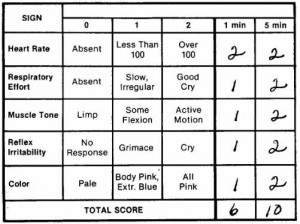The initial APGAR scoring is performed in the delivery room by the physician.
APGAR scoring is a method of evaluating the condition of the newborn at one minute and at five minutes after delivery. See figure 8-4 for an APGAR scoring chart.
a. Purpose.
The APGAR scoring chart is used to evaluate the conditions of the baby at birth, determine the need for resuscitation, evaluate the effectiveness of resuscitative efforts, and to identify neonates at risk for morbidity and mortality.
b. Objective Signs Used for Evaluation.
(1) Heart rate.
(2) Respiratory effort.
(3) Muscle tone.
(4) Reflex irritability.
(5) Color.

c. Scoring.
(1) Evaluations at each of the five categories are initially done at one minute after birth.
(2) Each item has a maximum score of two and a minimum score of zero.
(3) The final APGAR score is the sum total of the five items, with a maximum score of ten. The higher the final APGAR score, the better condition of the infant.
(4) Evaluations at one minute quickly indicate the neonate’s initial adaptation to extrauterine life and whether or not resuscitation is necessary.
(5) The five-minute score gives a more accurate picture of the neonate’s overall status, including obvious neurologic impairment or impending death.
